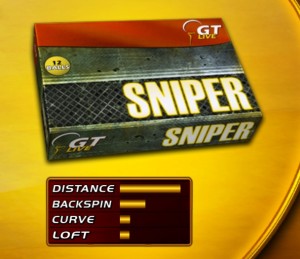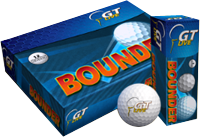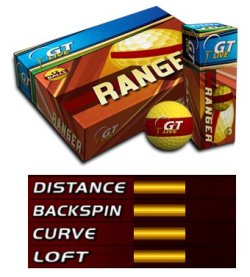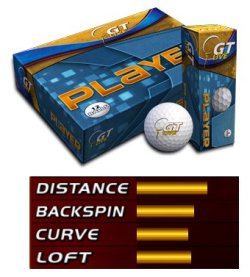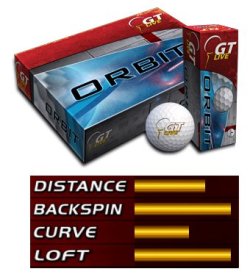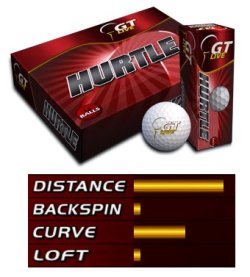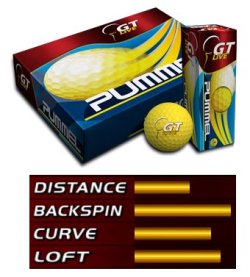You may have seen some pretty awesome YouTube shots this month where you saw someone (probably Putz) drive a par 4 that you never thought possible, just by hitting it straight. I’ll point out four pretty sweet examples:
Timber Bay #15
Grizzly Flats #7
Falcon Sands #6
Falcon Sands #7
I don’t even have examples of shots from Timber Bay #2 and #14 and Laurel Park #2 and #6, which can also be driven straight in some cases. And don’t forget about some of the par 5s where the extra distance off the tee can help you reach the green in two!
After seeing these examples, it’s pretty tempting to want to change to the Air-O balls and show off with these long drives in front of your friends! But not so fast – let’s take a look at how these balls can both help and potentially hurt your game.
First, you have to understand how the Air-O balls work. Introduced last year (as the red box balls), these balls have all the same properties as stock balls except for one important difference – if you hit a straight 180 shot off the tee, you get a big distance boost, resulting in somewhere around a 10-15% increase based off the club you select. The driver, for example, can average around 50 more yards than if you hit the normal stock balls. So, all of a sudden your 350-yard drives are now going 400 yards!
It’s not quite as easy as it sounds, though – you have to be very accurate with your pull back and follow through to trigger the distance increase. If you don’t create a straight line from your pull back angle through your follow-through angle within a degree or two, you won’t get the distance boost. I’d say pros trigger the boost 90-95% of the time, but players like you and me might only be in the 75-80% range, especially when you are trying to angle the shot off to the side (actually, sometimes straight back and straight forward can be challenging too)!
When you consider the fact that the penalty (water and par) can exceed the reward (an eagle putt) in some cases, you might second-think that shot – how confident are you? It certainly adds a fun but potentially stressful aspect to the game!
And here’s another issue you’ll come to discover – the balls can be a hindrance on par 3s and normally drivable par 4s. How so? Well, you may be put in a spot where you really want to hit a B2 shot with a particular club – but, now you have to adjust your strategy because that B2 could trigger a distance boost where you’ll overshoot the green! You either have to hit the same club with a little bit of cut, club up and thumb the shot, or club down and hit the B2 planning to use the boost. While having to learn and use different kinds of shots can help amateurs get better down the road, it’s certainly frustrating to have to veer from your comfort zone.
Finally, since the Air-Os act like stock balls in every other situation, you may be losing back to the field in several other situations – especially cut shots and some approach shots. This deduction is not significant enough to figure in for amateurs, but you could theoretically drop another fraction of a stroke from the benefit shown for pros.
All of a sudden, the Air-Os might not seem like the best option for amateur players, but how can we know for sure? Let’s break down each course to see if the potential benefits outweigh the downfalls that these balls can cause.
Click here to view a breakdown of each course and how amateur players might see their scores change as opposed to pro players using the Air-Os. The sheet makes the following assumptions:
- You won’t always get a setup where you can take advantage of the extra distance. Column D is my best guess for how often the hole sets up to potentially give you a stroke advantage. As you can see, some holes very rarely set up for it, so you’ll only get the chance to benefit every once in a while.
- On some holes, the Air-Os may offer a significantly easier approach shot (a chush, for example) without risk of getting in trouble. Where this is the case, I’m assuming that’s worth a quarter stroke.
- If the balls give you a shot at an easier approach but come with risk of losing a stroke, I’m assuming you’ll be smart and lay up, so there’s no advantage there.
- Judging from the surroundings, a missed boost could cost you either 0, 1 or 2 strokes. If it could be one or the other, I’ll average those instances.
- Column I assesses the impact on amateurs who effectively trigger the boost 75% of the time. I’ll also assume that even if you trigger the boost, you’ll only accurately nail the landing area you need 75% of the time. Pros get 90% for both. I also have a column of the accuracy required to break even, and what you could expect if you were perfect 100% of the time.
- For normal par 3s and normally straight drivable par 4s, amateurs will be penalized a quarter stroke if you could lose 1 stroke, and you’ll be penalized a half stroke if you could lose two strokes. This is assuming you’ll have to adjust from your normal B2 shot half the time, and half of that time you’ll lose a stroke or two because of it. Pros lose a tenth of a stroke for 1 and two tenths for 2.
So, let’s take a look at row 5 for Alpine hole #4. This hole offers one of the most significant advantages on any course if you have the Air-Os. I’m guessing that 80% of the time you’ll have a shot to stick this green where people using other balls won’t. However, there’s chance of a snow plug or even water if you mishit the shot, so it could cost you a stroke (water and par) or nothing (snow plug or long with a chip and a birdie).
Let’s say you play this hole 100 times and use birdie as the base. It sets up 80% of the time for the boost shot, so you’re at +80. Of those 80 attempts, you’ll miss the boost 25% of the time (20 times), with it costing you par half of those and birdie (no harm) the other half. So that’s -10 more, putting you at +70. Now, even when you do hit the boost correctly the other 60 times, you’ll be inaccurate 25% of the time (15 times), putting you at +55. So, in summary, you can expect to eagle 55% of the time when others are getting birdies.
Pros are 90% accurate, so when you plug in 10% and 90% instead, they gain a stroke 69% of the time they play the hole with the Air-Os.
In summary, this grid shows how amateurs and pros may expect their scores to differ on each course by using the Air-Os. You’ll also see how accurate you have to be with your shot-making just to break even using these balls, and how you could potentially benefit if you had perfect control of this shot!
| Course |
Amateur Strokes |
Pro Strokes |
Break even % |
Perfect Strokes |
| Alpine Run |
-0.58 |
0.74 |
82% |
2.38 |
| Timber Bay |
-1.38 |
0.28 |
87% |
1.65 |
| Laurel Park |
-0.66 |
0.10 |
90% |
1.60 |
| Grizzly Flats |
-1.67 |
0.04 |
90% |
1.45 |
| Falcon Sands |
-1.76 |
-0.30 |
93% |
0.93 |
| TOTAL |
-6.05 |
0.85 |
88% |
8.01 |
So, while it may be fun to play a few rounds with the Air-Os, you’ll likely see your game suffer over the long haul. Stick with the Hawks or Flares and the Maniax and continue to focus on shot-making!





